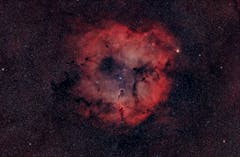Astronomik H-alpha 12nm CCD MaxFR 31mm
MaxFR Astronomik photographic narrowband-emission line filters for fast optical systems.
There is an ever-growing demand for filters suitable for extremely fast optical systems like Celestron’s RASA and the Epsilon Astrographs made by Takahashi.
Our novel MaxFR emission line filters are suitable for very fast focal ratios. The new Astronomik MaxFR series of narrowband-emission line filters is perfectly matched to the requirements of astronomical deep-sky imaging with fast optical systems. For the three most important emission lines of oxygen (OIII), hydrogen (H-alpha), and sulfur (SII), you may select your filters either with 12nm or 6nm Bandwidth (FWHM).
Key Features:
- Highest transmission: MaxFR filters are designed with the well-known MFR Coating technique that provides the best out-of-band blocking possible across the entire range of wavelengths from UV up to IR. This offers extremely high contrast, minimized stray light, no halos, and needle-sharp stars. These filters deliver the best data quality for processing stunning final images.
- 12nm MaxFR filters: Suitable for use from f/1.7 to f/8, with about 85% of maximum transmission at f/1.4.
- 6nm MaxFR filters: Usable from f/2.2 to f/8, with approximately 90% of maximum transmission at f/2.
- Maximum contrast achieved with careful design, blocking all unwanted wavelengths, including H-alpha and NII for SII filters.
Imaging with Narrowband-Emission Line Filters:
If you must observe from light-polluted areas (as most of us do), imaging with narrowband-emission line filters is the best way to capture high-quality images, as all types of light pollution can be effectively blocked! Typically, an H-alpha filter is the first step into deep-sky astrophotography, allowing you to capture detailed and high-contrast images, even with heavy light pollution or under a full moon.
An OIII filter expands your imaging possibilities by enabling you to capture greenish/blueish structures, such as planetary nebulae and star-forming regions. The SII filter completes your HSO-set, allowing you to process your images similarly to Hubble Space Telescope pictures!
Quality Aspects of Astronomik MFR Narrowband-Emission Line Filters:
- MFR Coating: The 12nm filters can be used on all instruments down to f/1.4, and the 6nm filters down to f/2.
- High-Quality substrate: Astronomik filters are made with stress- and striae-free, optically polished glass, with ultra-thin layers applied to this substrate.
- Parfocal filters: Astronomik filters are Parfocal! The small thickness tolerance ensures the focal plane remains unchanged when switching filters.
- Durability: Astronomik filters are highly scratch-resistant, moisture-resistant, and do not degrade over time. Every filter performs at full capacity upon shipment and will continue to do so for many years.
- Integrated Blocking: Unwanted light is blocked across the full spectral range from UV to IR, eliminating the need for additional UV & IR blockers when imaging with Astronomik filters.
- Available sizes: Filters are available from 1.25" up to square 50mm x 50mm sizes.
- Filters are delivered in a high-quality protection and storage box with a 10-year guarantee.
With every Astronomik filter, you get the highest quality possible, ensuring perfect images with your instruments. Particularly useful for combating light pollution, the narrowband-emission line filters will greatly expand your imaging capabilities. By investing in these filters, you are purchasing accessories that will perform just as well after many years as they did when new, thanks to Astronomik's special coating technique.
Common Questions:
- Which is better: 12nm or 6nm? For cameras with extremely low dark current and effective cooling, 6nm filters provide better results, with longer exposures yielding deeper images. However, 12nm filters are the best option for DSLR cameras and dark-current-limited systems. 6nm filters are ideal for heavy light pollution and when maximum contrast and star reduction are necessary.
- How much does exposure time increase? Exposure times do not necessarily need to increase, but they can be extended for better results. Since narrowband filters block unwanted light so effectively, the background remains dark, allowing for longer exposures to capture fainter details.
Select your filter size and FWHM to see all available options.
















